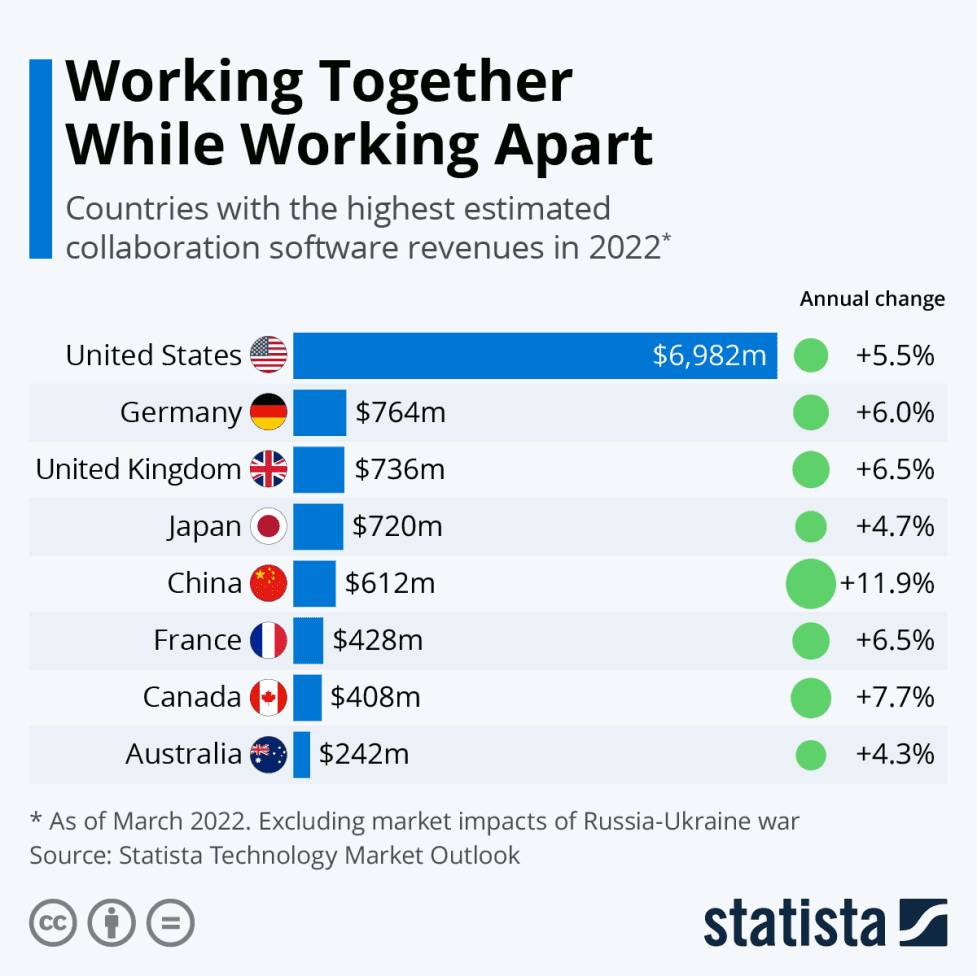
It doesn’t really matter where your workforce is located or how large it is. They could all be in one geographical location, they could be scattered across multiple sites, or some of them could even be working at home as part of a remote or hybrid working model. Wherever they are, there will be times when the need for collaboration is a necessity for operational efficiency.
It also doesn’t matter what sector you operate in. Collaboration should be a ‘must do’ in any type of business. Yet despite the numerous tools and platforms that encourage and help with collaboration, it is something many businesses still struggle with.
But, just what is cross-functional collaboration? And how do you overcome the barriers to cross-functional collaboration in your organization?
What is cross-functional collaboration?

Consider for a moment how your business operates. You’ll find that collaboration permeates almost every aspect of your organization, from logistics working with your sales department to your product designers working together with your marketing teams. In fact, without collaboration of some sort, your business would struggle to survive.
Cross-functional collaboration more specifically refers to a project that requires input from various teams and/or departments within your organizations. While those teams may have different skills and functions, they are all working together towards a common identified goal. For example, you may be working on a hybrid communications project that will require input from teams with different skill sets.
You may find, or have found, that your organization has several silos. Your marketing team may operate completely separately from your logistics team and so on. That can mean that communication is inefficient and that collaboration may be non-existent. Encouraging cross-functional collaboration can reduce the negative effects of those silos.
There are cases where such collaboration can occur organically and without any intervention from you. Someone in your marketing team might contact one of your design team to get more information on a specific product to help them market it and inform customers so that your sales figures can be boosted.
However, in most cases, to achieve a good level of cross-functional collaboration, some intervention from you or other managers will likely be needed. It could be as simple as introducing new systems for good time management or it could involve implementing new tools and technology that aid with collaboration.
Barriers to cross-functional collaboration and their solutions
The first thing to do is to look closely at how your business operates and what barriers exist to efficient levels of collaboration. You can make a list with the major barriers at the top and then have the other barriers in descending order. Only once you know what barriers exist can you implement ideas and tools that encourage and optimize collaboration.

1. Communication
How good is communication within your organization? You may be using solutions such as cloud based telephony solutions to improve communications with customers and suppliers but how is your workforce communicating with each other? If you don’t have good internal communications solutions, then you have a major barrier to any form of collaboration.
It can also help to review the different forms of internal communication you could use. After all, every type of technology may face issues at some point and there’s nothing more frustrating than having it breakdown.
Solution: Fostering communication culture
Fixing your internal communication issues starts with identifying what and where the problem is. To do this, talk to multiple departments to see where the communication and workflow inefficiencies are and how things can be improved. Implement their suggestions and plan a review process so that ideas can be tried, tested and improved on.
Crucially, you also need to foster a culture of good communication. This can start with something simple, for example by making sure everyone is introduced and knows who to ask–it might sound basic but it’s often overlooked. Then, start building and reinforcing new communication skills, by running active and empathetic listening training sessions and ensuring that you recognise and reward good communication.
2. Location
Ensuring your workforce is connected regardless of location is a major piece in the cross-functional collaboration puzzle.
Even in this modern age, where your staff are located can be a barrier to efficient collaboration. When there is a real physical distance between individuals and teams, there can sometimes be a reluctance to collaborate and difficulties with communication. Perhaps this is a ‘throwback’ to the days when things could be discussed in a break room or even by the water cooler, but it is a barrier you have to break down.

Solution: Technology
Technology and tools will play a major part in bridging location gaps and optimizing your cross-functional collaboration. The type of technology you choose will depend very much on the type of business you do as well as where your workforce is located.
For example, if you have a largely remote or hybrid workforce, then you will want to look at communications tools that allow for such things as video conferencing and file sharing. Consider tools such as 8x8’s cloud communications solutions, so you can ensure that staff collaborating is as easy as if they were in the same room.
On top of this, look into teamwork management tools such as Trello, so that everyone can follow a clear workflow, or TIMIFY, so teams can schedule remote meetings easily.
By listening to your staff and what they feel they need to achieve effective collaboration, then it can make it easier for you to list possible solutions. It can also be of enormous benefits if you choose technology that integrates with your existing systems.
3. Resistance to change
This can be a major barrier in many areas, not just collaboration. But if the world had simply given into such resistance, then we’d still be traveling by horse. The world has constantly moved forward and embraced new technologies and systems and people being used to the old way of doing things can be a barrier that you have to address.
That resistance can also be due to a lack of trust in an organization’s leadership which in turn can be because of a lack of transparency from that leadership and poor communications from the top down. Combined with other factors such as location, this is something you have to address in order to ensure optimized levels of collaboration.
Solution: Plan
To mitigate against the risk of resistance to change and your new ideas falling flat, you need to have a clear plan. Then, it’s essential that you communicate this plan to your entire workforce, to help to ensure that everyone is onboard and working together.
You should have already identified what barriers exist within your organization so that should form the basis of your plan. Your plan should list the particular barriers and potential solutions. You should also include any timeframe for implementing solutions as well as primary stakeholders.
Finally, if you have a larger organization, there should also be clearly-defined roles as to who will take the lead on the plan as a whole and on individual components of that plan.

4. Differing priorities
Of course, different teams are going to have different priorities, it’s one of the main reasons silos exist in your organization. Your marketing team may be focusing on an ad campaign while your customer service team may be concentrating on ensuring great levels of customer service.
However, if you drew a Venn diagram of what different teams do, there will be plenty of intersecting points. There will, of course, be common goals that various teams are working towards, e.g., more sales, but you may find that there are also connections between teams that they hadn’t previously understood or realized, such as budget considerations.
Solution: Processes
Of course, different teams and silos may have different ways of doing things. While some of those processes may be specific to the work they do and unavoidable, there are many processes that your teams will share.
Start by looking to identify common priorities to help improve remote team collaboration. Having your teams recognize the common goals they share is a major step towards effective cross-functional collaboration.
As you move forward with your plan, consider which processes they do share and ensure that you standardize them. For example, where possible try to align softwares and workflow processes to create a basic level of familiarity across different teams. This will make things far easier when it comes to collaboration as your teams will be following standard templates.
Optimizing cross-functional collaboration
You may not get things exactly right the first time. Optimizing your cross-cultural collaboration can be complicated and it can take time to get it to peak efficiency. It’s essential that you monitor any changes as an ongoing process. That includes listening to feedback from the people who matter; your staff.
While it may be impossible to reverse some major decisions such as investment in technology, it is possible to change how you use that tech. Focus on workflows and processes so that they work well and that delays and logjams are avoided.
Moreover, implementing tools for attendance monitoring can help ensure that teams are aligned and contributing effectively to collaborative projects. Regularly tracking attendance and participation levels can provide insights into engagement and allow for timely interventions to optimize collaboration.
The takeaway

In increasingly competitive markets, good collaboration can help boost your chances of success as well as important metrics such as conversion rates and customer retention. It can also mean the difference in getting a product ready for the market before your competitors, something that can be crucial for your revenue streams.
At the heart of efficient cross-functional collaboration lies good communications. This is something that should be the primary focus of any collaboration plan. That communication does not only include the tools and technology you use, but how your staff use it too. This can be especially important when you have staff working in different locations. Remember, it may seem like hard work but good collaboration and better results are achievable.
Related articles



